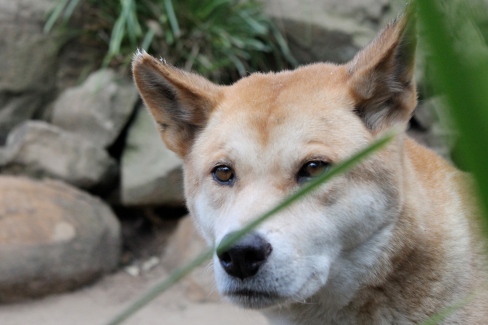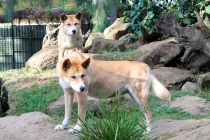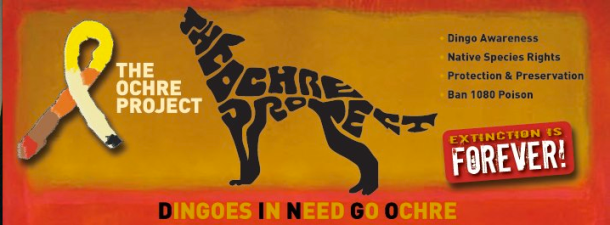Sodium Flouroacetate, better known as 1080, is a poison to humans and most animals. A prolonged and painful death usually comes through ventricular arrhythmias. One teaspoon of 1080 can kill up to 100 humans. There is no antidote. As a bait it is banned in most countries of the world to protect wildlife and ecosystems. But not in Australia, where it is used to kill one of the most beautiful indigenous species: the dingo.
According to Aborigines, dingoes are sacred animals. They believe dingoes can perceive evil spirits undetectable for humans. It came to the Australian continent about five thousand years ago and, thus, is one of the most represented animal in the Aboriginal culture.
But you don’t need ancient wisdom do recognise the grace and the importance of this species. As the only apex predator of Australia the dingo is essential for a functioning ecosystem.
An endangered pest?
The dingo is internationally classified on the “Red List” as vulnerable since 2004 – but not in Australia. In Queensland, the dingo is classified as a pest. But the laws differ from state to state. In the Northern Territory, the dingo is protected under the Territory Parks and Wildlife Conservation Act (2000), but it is legal to kill them if they are a threat to livestock farming. In other states the protection of dingoes is mainly limited to those that live in national parks and zoos, the others are required by law to be hunted.
Dying from 1080 intoxication is a long and painful death, it can take up to 30 hours. The Royal Society for the Prevention of Cruelty to Animals Australia militates against the use of 1080, even for introduced species that are a threat to the wildlife. It
“recognises the need to control introduced species, such as the fox, to reduce both environmental and agricultural impacts. However, we argue that the control methods used should be as humane as possible. The RSPCA has conducted a review (…) of 1080 and the evidence indicates that 1080 is not a humane poison.“
Other animals, like Wedge Tailed Eagles, eat the baits as well. Entering the food chain and the water cycle the poison can have several side effects. Furthermore, killing dingoes can cause an imbalance in the ecosystem. Australian authorities, however, call it “Dingo Management”.
Ochre – the colour of dingoes
This is a loud call for action, is what Jennifer Britton Parkhurst thought, when she founded the Ochre Project this year. She expressed her worries towards SBWire:
- In researching the breed, I discovered the carnage and agony these animals go through in Australia. If change is not immediate, this essential and beautiful species will be extinct in 20 years and the ecosystem will be permanently damaged.
Jennifer Britton Parkhurst is upset about the method of using 1080 to “manage” the dingos. She says to SBWire:
- I am also shocked that 1080 is so lethal and that very little information is available on how it is made and monitored. What if it fell into terrorist hands? Even the Nazis banned its use. It is an agonizing prolonged death.
On the website of the Ochre Project not only explains the brutality of how the dingoes are killed but also the necessity of reintroducing them in areas where there are already gone in order to save the Australian indigenous wildlife:
- Deakin University ecologist Euan Ritchie says this would Allow native animals to flourish and correct unbalanced Ecosystems. He said ‘We need a policy to bring dingoes back into the cattle Country in northern and central Australia so dingoes can Control cats and foxes.’
The Ochre Project was initiated to give voice to dingoes. They started campaigns to save dingoes and petitions to ban 1080. Its facebook website has more than 2,000 members by now. Don’t miss out on the National Dingo Day on 20th October and join the action.
A déjà-vu?
The thylacine, or Tasmanian wolf was systematically hunted since 1830, because it was said to be a threat to the livestock industry. The truth is that most sheep got killed by wild dogs. By 1860 the population of the Tasmanian wolf was limited to mountain regions, but the hunt continued. Counteractive measures came too late.
It was not before 1928 that the Tasmanian Advisory Committee for Native Fauna recommended to protect this species, eight years later the thylacine officially became protected. In the same year probably the last of its species died. The International Union for Conservation of Nature declared the Tasmanian wolf as extinct in 1982.
How you can help:
- Sign a petition to ban 1080
- Join the Ochre Project on Facebook
- Get informed: Website of wildlife photographer and activist Jennifer Parkhurst (similar name by coincidence)
More Information:
Related articles
- VOICE your outrage over the death of the 4 Dingo pups. (sunsetdaily.wordpress.com)
- Death of the Fraser Island dingo (waggingschool.wordpress.com)
- The Dingoes of Fraser Island (theeternaltraveller.wordpress.com)


